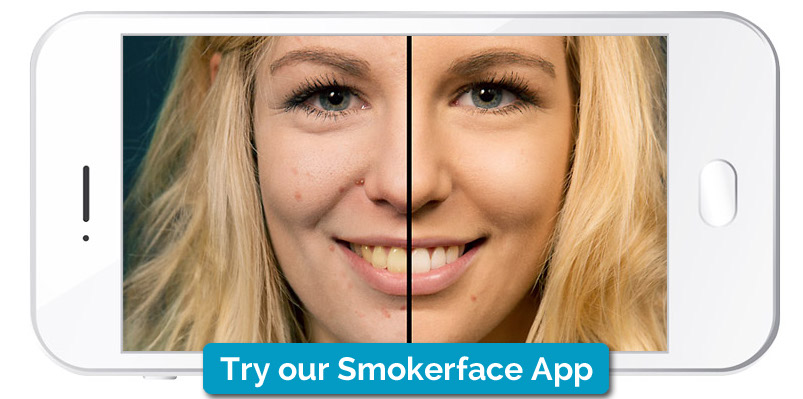
Smartphone use is exponentially increasing worldwide providing a novel opportunity to educate the public about the dermatologic side effects of tobacco. Peer-reviewed publications describe cigarette smoking to be associated with premature wrinkles, larger pores, premature grey hair and hairloss, pale skin and acne [1-5]. The relevance of dermatologic aspects for our target group of 12 to 16 year old students is portrayed by numerous publications demonstrating the influence of beauty aspects on self-confidence and quality of life of adolescents [6-8]. To this end, the free charity app Smokerface was developed and released by EAT medical student Titus J. Brinker for Android and iPhones.
How it works: 1) The app-user takes a selfie of his/her own face. 2) The app uses the photo to illustrate four scenarios: The user’s face in one year as a non-smoker/smoker and the user’s face in 15 years as a non-smoker/smoker. 3) The app provides explanations for the alterations and gives the user the opportunity to share his picture with family and friends.
National TV reports in Germany, Austria and Switzerland: Smokerface is capable of educating the public on a large scale: Five million viewers were confronted with the beauty reducing aspects of smoking due to the App release in Sept. 2014. 400.000 faces have been morphed by the app so far and it has been installed on 70.000 smartphones by March 2015.
Educating the majority of adolescents: No effective school-based smoking prevention programs exist that are implementable for the majority of countries or schools, owing to high costs, ineffective approaches or tutor availability [11]. The Smokerface app promoting poster campaign enables us to reach almost every student worldwide due to very low costs and no need for health educators. Its effectiveness is currently evaluated in a multicenter study in Germany involving over a hundred secondary schools. The investigators collaborate with professors from Harvard Medical School in order to optimize the study design. Our study protocol is currently in peer review and will be linked here soon.
A letter to the Editor on our app was published on 07/27/2015:
Brinker TJ, Seeger W
Photoaging Mobile Apps: A Novel Opportunity for Smoking Cessation?
J Med Internet Res 2015;17(7):e186
URL: http://www.jmir.org/2015/7/e186
DOI: 10.2196/jmir.4792
REFERENCES:
- Deborah Grady VE: Does Cigarette Smoking Make You Ugly and Old? Am J Epidemiol 135 (8): 839-842 1992.
- Okada HC, Alleyne B, Varghai K, Kinder K, Guyuron B: Facial changes caused by smoking: a comparison between smoking and nonsmoking identical twins. Plastic and reconstructive surgery 2013, 132(5):1085-1092.
- Trueb RM: Association between smoking and hair loss: another opportunity for health education against smoking? Dermatology 2003, 206(3):189-191.
- Schafer T, Nienhaus A, Vieluf D, Berger J, Ring J: Epidemiology of acne in the general population: the risk of smoking. The British journal of dermatology 2001, 145(1):100-104.
- Shen Y, Wang T, Zhou C, Wang X, Ding X, Tian S, Liu Y, Peng G, Xue S, Zhou J et al: Prevalence of acne vulgaris in Chinese adolescents and adults: a community-based study of 17,345 subjects in six cities. Acta dermato-venereologica 2012, 92(1):40-44.
- Dunn LK, O’Neill JL, Feldman SR: Acne in adolescents: quality of life, self-esteem, mood, and psychological disorders. Dermatology online journal 2011, 17(1):1.
- Kurtalic N, Hadzigrahic N, Tahirovic H, Sijercic N: [Quality-of-life of adolescents with acne vulgaris]. Acta medica Croatica : casopis Hravatske akademije medicinskih znanosti 2010, 64(4):247-251.
- Reljic V, Maksimovic N, Jankovic J, Mijovic B, Peric J, Jankovic S: Evaluation of the quality of life in adolescents with acne. Vojnosanitetski pregled Military-medical and pharmaceutical review 2014, 71(7):634-638.
